pandas borrows its dtypes from numpy. For demonstration of this see the following:
import pandas as pd
df = pd.DataFrame({'A': [1,'C',2.]})
df['A'].dtype
>>> dtype('O')
type(df['A'].dtype)
>>> numpy.dtype
You can find the list of valid numpy.dtypes in the documentation:
'?' boolean
'b' (signed) byte
'B' unsigned byte
'i' (signed) integer
'u' unsigned integer
'f' floating-point
'c' complex-floating point
'm' timedelta
'M' datetime
'O' (Python) objects
'S', 'a' zero-terminated bytes (not recommended)
'U' Unicode string
'V' raw data (void)
pandas should support these types. Using the astype method of a pandas.Series object with any of the above options as the input argument will result in pandas trying to convert the Series to that type (or at the very least falling back to object type); 'u' is the only one that I see pandas not understanding at all:
df['A'].astype('u')
>>> TypeError: data type "u" not understood
This is a numpy error that results because the 'u' needs to be followed by a number specifying the number of bytes per item in (which needs to be valid):
import numpy as np
np.dtype('u')
>>> TypeError: data type "u" not understood
np.dtype('u1')
>>> dtype('uint8')
np.dtype('u2')
>>> dtype('uint16')
np.dtype('u4')
>>> dtype('uint32')
np.dtype('u8')
>>> dtype('uint64')
# testing another invalid argument
np.dtype('u3')
>>> TypeError: data type "u3" not understood
To summarise, the astype methods of pandas objects will try and do something sensible with any argument that is valid for numpy.dtype. Note that numpy.dtype('f') is the same as numpy.dtype('float32') and numpy.dtype('f8') is the same as numpy.dtype('float64') etc. Same goes for passing the arguments to pandas astype methods.
To locate the respective data type classes in NumPy, the Pandas docs recommends this:
def subdtypes(dtype):
subs = dtype.__subclasses__()
if not subs:
return dtype
return [dtype, [subdtypes(dt) for dt in subs]]
subdtypes(np.generic)
Output:
[numpy.generic,
[[numpy.number,
[[numpy.integer,
[[numpy.signedinteger,
[numpy.int8,
numpy.int16,
numpy.int32,
numpy.int64,
numpy.int64,
numpy.timedelta64]],
[numpy.unsignedinteger,
[numpy.uint8,
numpy.uint16,
numpy.uint32,
numpy.uint64,
numpy.uint64]]]],
[numpy.inexact,
[[numpy.floating,
[numpy.float16, numpy.float32, numpy.float64, numpy.float128]],
[numpy.complexfloating,
[numpy.complex64, numpy.complex128, numpy.complex256]]]]]],
[numpy.flexible,
[[numpy.character, [numpy.bytes_, numpy.str_]],
[numpy.void, [numpy.record]]]],
numpy.bool_,
numpy.datetime64,
numpy.object_]]
Pandas accepts these classes as valid types. For example, dtype={'A': np.float}.
NumPy docs contain more details and a chart:

